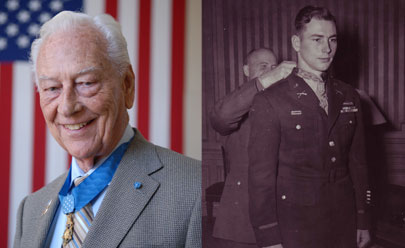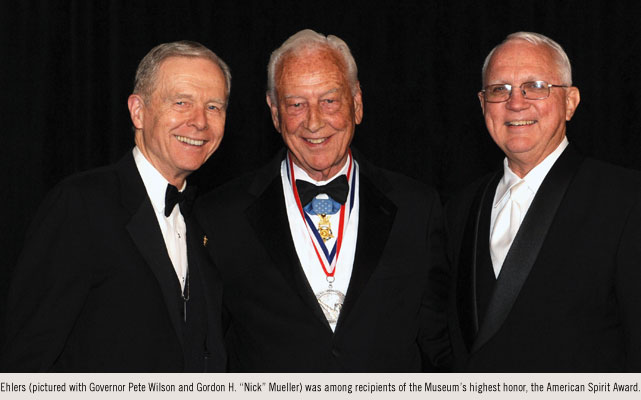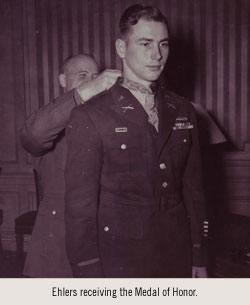FOCUS ON: WALT EHLERS

May 7, 1921 – February 20, 2014
Today, the nation lost one of its greatest heroes and the Museum lost a champion and a friend. Walter D. Ehlers served his country in World War II earning the Medal of Honor for actions at Normandy. He continued that service for the rest of his life through his work with the Veterans Administration and as a tireless advocate for the Museum.
"Among the many veterans who have helped to bring this Museum to life, Walt is probably the single most important, especially among Medal of Honor recipients," said Dr. Gordon "Nick" Mueller, Museum President & CEO. "His influence in bringing donors as well as the state and federal government to our cause has been extraordinary. Walt has been an inspiration to me personally, to our National Board of Trustees, to our members nationwide and, above all perhaps, to the visitors who come here to hear the story of the American WWII experience."
While Walt Ehlers' heroism and courage in attacking enemy strong points during the historic invasion of Normandy in June 1944 are well documented, he always noted the sacrifices of others, especially his brother Roland, who died during the Normandy invasion, often calling him his hero.
Ehlers was unflagging in his support for building the institution initially known as The National D-Day Museum. He was among Medal of Honor recipients from WWII who joined with dignitaries and thousands of veterans in New Orleans at the Museum's opening ceremonies on June 6, 2000. He participated in other major Museum ceremonies and in the institution's International Conference on World War II. The Museum has made prominent use of its oral history interview with Ehlers. For the Museum’s historians, he helped open doors among other Medal of Honor recipients, making additional high-priority interviews possible. And in the aftermath of Hurricane Katrina, Ehlers made a passionate appeal to state officials deciding whether to provide millions of dollars in recovery monies to The National WWII Museum. These funds were approved and later devoted to building the Campaigns of Courage: European and Pacific Theaters pavilion. The Road to Berlin galleries in the pavilion will open to the public later this year.
"His strong voice and appeal on behalf of veterans, living and deceased, was perhaps the decisive moment in securing the grant for the Museum," said Mueller.

View Mr. Ehlers full, unedited oral history on the Museum’s Digital Collections website.
Walt Ehlers: A History of Service
Raised in Kansas, Walt Ehlers enlisted with older brother Roland at Fort Riley in 1940. He had to gain his mother’s permission for enlistment because of his age. He was assigned to the 3rd Infantry Division and the 1st Infantry Division.
The brothers fought in the same company in North Africa and Sicily, and Walt transferred to another during training for D-Day at Normandy. During Operation Torch in North Africa, Ehlers was upset at the sight of artillery hitting a man on the beach at Casablanca, and he later took part in the Battle of El Guettar, a major engagement where US artillery dueled with German tanks.
Ehlers was wounded in the back during the hedgerow fighting that led to the Medal of Honor. During the fight across France, Walt Ehlers was wounded in the left thigh during a bombing at St. Lô; he rejoined his unit at the Hurtgen Forest and got wounded again there, in the right leg and both shoulders. After taking over command of a platoon at the Battle of the Bulge, he was wounded in the right leg. In an interview for WWII Magazine, published in early 2012, he said of his final wound, "I’ve still got the bullet in there. The Germans didn’t leave much of me untouched." Ehlers' combat tour ended when his unit reached the Weser River.
Ehlers had no idea that he would be getting the Medal of Honor until he heard about it from someone who read about it in Stars and Stripes. For his service, he earned three Purple Hearts, a Silver Star and the Medal of Honor, the nation's highest tribute.
Following the war, Ehlers became an advocate for military veteran benefits, interviewing a wide range of veterans through his work with the Veterans Association. He also enjoyed recounting that he served as a security guard for Disneyland when it opened in California.
Medal of Honor Citation
 For conspicuous gallantry and intrepidity at the risk of his life above and beyond the call of duty on 9 – 10 June 1944, near Goville, France. S/Sgt. Ehlers, always acting as the spearhead of the attack, repeatedly led his men against heavily defended enemy strong points exposing himself to deadly hostile fire whenever the situation required heroic and courageous leadership. Without waiting for an order, S/Sgt. Ehlers, far ahead of his men, led his squad against a strongly defended enemy strong point, personally killing 4 of an enemy patrol who attacked him en route. Then crawling forward under withering machinegun fire, he pounced upon the guncrew and put it out of action. Turning his attention to 2 mortars protected by the crossfire of 2 machineguns, S/Sgt. Ehlers led his men through this hail of bullets to kill or put to flight the enemy of the mortar section, killing 3 men himself. After mopping up the mortar positions, he again advanced on a machinegun, his progress effectively covered by his squad. When he was almost on top of the gun he leaped to his feet and, although greatly outnumbered, he knocked out the position single-handed. The next day, having advanced deep into enemy territory, the platoon of which S/Sgt. Ehlers was a member, finding itself in an untenable position as the enemy brought increased mortar, machinegun, and small arms fire to bear on it, was ordered to withdraw. S/Sgt. Ehlers, after his squad had covered the withdrawal of the remainder of the platoon, stood up and by continuous fire at the semicircle of enemy placements, diverted the bulk of the heavy hostile fire on himself, thus permitting the members of his own squad to withdraw. At this point, though wounded himself, he carried his wounded automatic rifleman to safety and then returned fearlessly over the shell-swept field to retrieve the automatic rifle which he was unable to carry previously. After having his wound treated, he refused to be evacuated, and returned to lead his squad. The intrepid leadership, indomitable courage, and fearless aggressiveness displayed by S/Sgt. Ehlers in the face of overwhelming enemy forces serve as an inspiration to others.
For conspicuous gallantry and intrepidity at the risk of his life above and beyond the call of duty on 9 – 10 June 1944, near Goville, France. S/Sgt. Ehlers, always acting as the spearhead of the attack, repeatedly led his men against heavily defended enemy strong points exposing himself to deadly hostile fire whenever the situation required heroic and courageous leadership. Without waiting for an order, S/Sgt. Ehlers, far ahead of his men, led his squad against a strongly defended enemy strong point, personally killing 4 of an enemy patrol who attacked him en route. Then crawling forward under withering machinegun fire, he pounced upon the guncrew and put it out of action. Turning his attention to 2 mortars protected by the crossfire of 2 machineguns, S/Sgt. Ehlers led his men through this hail of bullets to kill or put to flight the enemy of the mortar section, killing 3 men himself. After mopping up the mortar positions, he again advanced on a machinegun, his progress effectively covered by his squad. When he was almost on top of the gun he leaped to his feet and, although greatly outnumbered, he knocked out the position single-handed. The next day, having advanced deep into enemy territory, the platoon of which S/Sgt. Ehlers was a member, finding itself in an untenable position as the enemy brought increased mortar, machinegun, and small arms fire to bear on it, was ordered to withdraw. S/Sgt. Ehlers, after his squad had covered the withdrawal of the remainder of the platoon, stood up and by continuous fire at the semicircle of enemy placements, diverted the bulk of the heavy hostile fire on himself, thus permitting the members of his own squad to withdraw. At this point, though wounded himself, he carried his wounded automatic rifleman to safety and then returned fearlessly over the shell-swept field to retrieve the automatic rifle which he was unable to carry previously. After having his wound treated, he refused to be evacuated, and returned to lead his squad. The intrepid leadership, indomitable courage, and fearless aggressiveness displayed by S/Sgt. Ehlers in the face of overwhelming enemy forces serve as an inspiration to others.
Walt Ehlers will forever serve as an inspiration to all of us at The National WWII Museum.
Walt Ehlers’ speech at the grand opening of The National D-Day Museum in June 2000.


